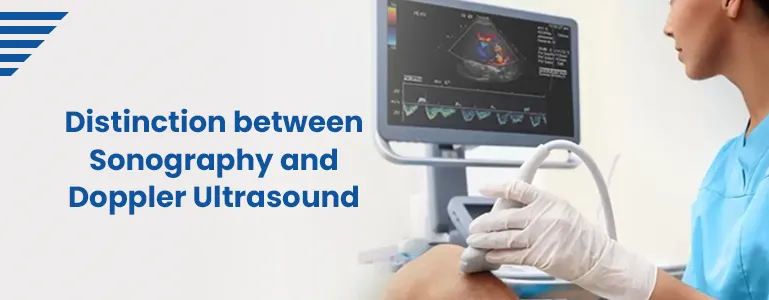Distinction between Sonography and Doppler Ultrasound

Medical imaging plays a pivotal role in modern healthcare, aiding clinicians in diagnosing and monitoring various conditions. Among the many imaging techniques available, sonography and Doppler ultrasound are two widely used methods that offer invaluable insights into the human body. While they might seem similar at first glance, they serve different purposes and provide distinct information. In this blog, we'll delve into the differences between sonography and Doppler ultrasound, highlighting their applications and advantages.
Home Sample Collection
Understanding Sonography:
Sonography, commonly known as ultrasound,employs high-frequency sound waves and is a non-invasive imaging method to create real-time images of internal body structures. These images, also referred to as sonograms or ultrasounds, allow medical professionals to visualize organs, tissues, and even developing fetuses in pregnant women. Sonography is particularly valuable during pregnancy for monitoring fetal development, identifying potential complications, and determining the baby's position
Advantages of Sonography:
Non-invasive: Sonography doesn't involve radiation exposure or invasive procedures, making it safe for patients of all ages, including pregnant women and infants.
Real-time imaging: Sonography provides real-time images, which can assist in directing procedures like needlesticks and biopsies aspirations.
Versatility: It can be used to examine various parts of the body, including abdominal organs, pelvis, heart, blood vessels, and even the musculoskeletal system.
Portability: Sonography machines are relatively portable, allowing for bedside examinations and point-of-care imaging.
Understanding Doppler Ultrasound:
Doppler ultrasound, a specific application of ultrasound, focuses on measuring the movement of blood flow within blood vessels. This technique utilizes the Doppler effect to assess the velocity and direction of blood flow. By detecting changes in the frequency of sound waves reflected off moving blood cells, Doppler ultrasound helps clinicians evaluate blood circulation, detect blockages or abnormalities, and assess the function of the heart and blood vessels.
Advantages of Doppler Ultrasound:
Blood flow assessment: Doppler ultrasound provides crucial information about blood flow dynamics, aiding in the diagnosis of conditions like deep vein thrombosis (DVT), peripheral artery disease (PAD), and other vascular disorders.
Early detection: Doppler ultrasound can identify narrowing or blockages in blood vessels before they lead to severe complications like stroke or heart attack.
Non-invasive: Similar to conventional sonography, Doppler ultrasound is non-invasive and eliminates the need for contrast agents or radiation exposure.
Real-time monitoring: Doppler ultrasound enables real-time monitoring of blood flow changes, helping doctors make informed decisions during surgical procedures or interventions.
Key Differences:
Purpose: Sonography is primarily used to visualize internal organs and tissues, while Doppler ultrasound focuses on assessing blood flow within blood vessels.
Imaging Modality: Sonography generates images based on the reflection of sound waves off tissues, while Doppler ultrasound utilizes the Doppler effect to assess the movement of blood cells and calculate blood flow velocity.
Applications: Sonography is versatile and can be used for a wide range of examinations, from assessing pregnancies to evaluating abdominal and musculoskeletal structures. Doppler ultrasound is specifically tailored to analyze blood flow and is used in cases related to cardiovascular and vascular health.
Conclusion:
Both sonography and Doppler ultrasound are essential tools in modern medical practice, each with its own unique capabilities and applications. Sonography provides detailed images of internal structures, aiding in the diagnosis of various conditions, while Doppler ultrasound is crucial for assessing blood flow dynamics and vascular health. By understanding these differences, healthcare professionals can make more informed decisions about which imaging technique to use based on the patient's needs, ensuring accurate diagnoses and effective treatment plans.
Frequently Asked Questions
What is the main difference between sonography and Doppler ultrasound?
Sonography involves the use of high-frequency sound waves to produce live images of the interior organs and tissues, providing detailed visual information about their structure. Doppler ultrasound, on the other hand, focuses on assessing the movement and velocity of blood flow within blood vessels by utilizing the Doppler effect. It doesn't create detailed images of organs like sonography does; instead, it provides information about the direction and speed of blood circulation.
Can both sonography and Doppler ultrasound be used during pregnancy?
Yes, both sonography and Doppler ultrasound have applications during pregnancy. Sonography is commonly used to monitor the development of the fetus, assess its position, and detect any potential abnormalities. Doppler ultrasound, in this context,May be used to assess the umbilical cord's blood flowand fetal vessels, helping doctors ensure proper oxygen and nutrient supply to the developing baby.
Are sonography and Doppler ultrasound safe procedures?
Yes, both sonography and Doppler ultrasound are considered safe procedures. They are non-invasive and do not involve exposure to ionizing radiation, making them suitable for patients of all ages, including pregnant women and infants. However, as with any medical procedure, it's important for healthcare professionals to consider individual circumstances and use these techniques appropriately.
Can sonography and Doppler ultrasound be performed at the bedside?
Yes, both techniques can be performed at the bedside. Sonography machines are often portable and can be used for point-of-care imaging, which is particularly beneficial in emergency situations or when a patient's condition requires immediate assessment. Similarly, Doppler ultrasound can also be performed at the bedside to quickly evaluate blood flow in critical situations.
What types of conditions can be diagnosed using sonography?
Sonography is versatile and can be used to diagnose a wide range of conditions. It is commonly used to examine abdominal organs such as the liver, kidneys, and gallbladder, as well as the heart, thyroid, and musculoskeletal structures. In obstetrics, it's crucial for monitoring pregnancies and detecting fetal abnormalities. It can also aid in identifying cysts, tumors, and other growths within the body.
How does Doppler ultrasound help in diagnosing vascular conditions?
Doppler ultrasound is instrumental in diagnosing vascular conditions by assessing blood flow dynamics. It can detect abnormalities like blood vessel narrowing, blockages, and blood clots. In conditions like peripheral artery disease (PAD) and deep vein thrombosis (DVT), Doppler ultrasound can provide information about blood flow velocity, direction, and pressure, helping doctors determine the severity of the condition and plan appropriate treatment.
Are there any limitations to using sonography and Doppler ultrasound?
While both techniques are valuable, they do have limitations. Sonography might struggle to penetrate through bones or air-filled structures, limiting its effectiveness in certain areas. Doppler ultrasound might have challenges in assessing very slow or turbulent blood flow accurately. Additionally, the expertise of the operator plays a significant role in obtaining accurate and reliable results for both techniques.
Can both sonography and Doppler ultrasound be used for heart examinations?
Yes, both techniques can be used for heart examinations, but they provide different types of information. Sonography can visualize the heart's structure, chambers, valves, and assess overall heart function. Doppler ultrasound focuses on evaluating blood flow through the heart and blood vessels, helping diagnose conditions like heart valve disorders and assessing the efficiency of blood circulation.
Do patients need to prepare differently for sonography and Doppler ultrasound?
For the most part, preparations for both sonography and Doppler ultrasound are similar. Patients might be asked to wear loose-fitting clothing and avoid applying creams or lotions to the area being examined. However, specific instructions might vary based on the purpose of the examination and the body part being studied. Before the procedure, pay close attention to the directions the healthcare professional gives you
Which technique should be chosen when, sonography or Doppler ultrasound?
The choice between sonography and Doppler ultrasound depends on the clinical question and the information needed. If the goal is to visualize internal structures and organs in detail, sonography is the appropriate choice. If assessing blood flow dynamics within blood vessels or evaluating cardiovascular conditions is the objective, Doppler ultrasound is the preferred method. Healthcare professionals will decide which technique to use based on the patient's symptoms, medical history, and the diagnostic information required
Book Appointment
Our Locations Near You in Hyderabad
3KM from Banjara Hills
1.9KM from Yusufguda
3KM from Madhura Nagar
5KM from Shaikpet




